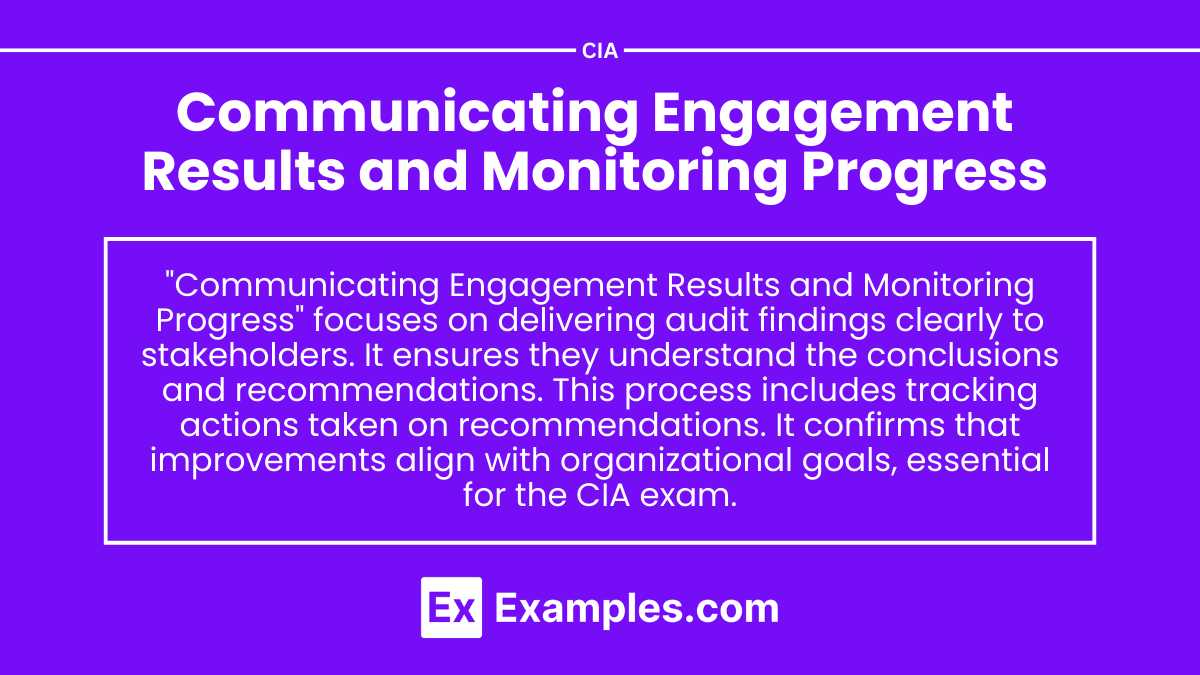Preparing for the CIA Exam requires a thorough grasp of “Communicating Engagement Results and Monitoring Progress,” a critical aspect of auditing practice. This area emphasizes an auditor’s ability to effectively communicate findings, recommendations, and conclusions to stakeholders while ensuring transparency and accuracy. Additionally, it focuses on the auditor’s role in monitoring the implementation of agreed-upon actions, assessing progress, and validating improvements over time. Mastering these skills ensures auditors can provide stakeholders with valuable insights, foster continuous improvement, and reinforce accountability within the organization, which is essential for success on the CIA Exam.
Learning Objectives
In studying “Communicating Engagement Results and Monitoring Progress” for the CIA exam, you should aim to understand the importance of delivering clear, structured audit reports that effectively convey findings and recommendations to stakeholders. Focus on the principles of report writing, ensuring that reports are concise, objective, and tailored to the organization’s goals. Recognize the value of constructive feedback to promote actionable improvements in governance, risk management, and control processes. Develop techniques for tracking and following up on audit recommendations, monitoring progress to confirm that corrective actions are implemented. Additionally, emphasize the role of continuous engagement with stakeholders to support accountability and reinforce sustained improvements across the organization.
Core Objectives
1. Reporting Audit Findings
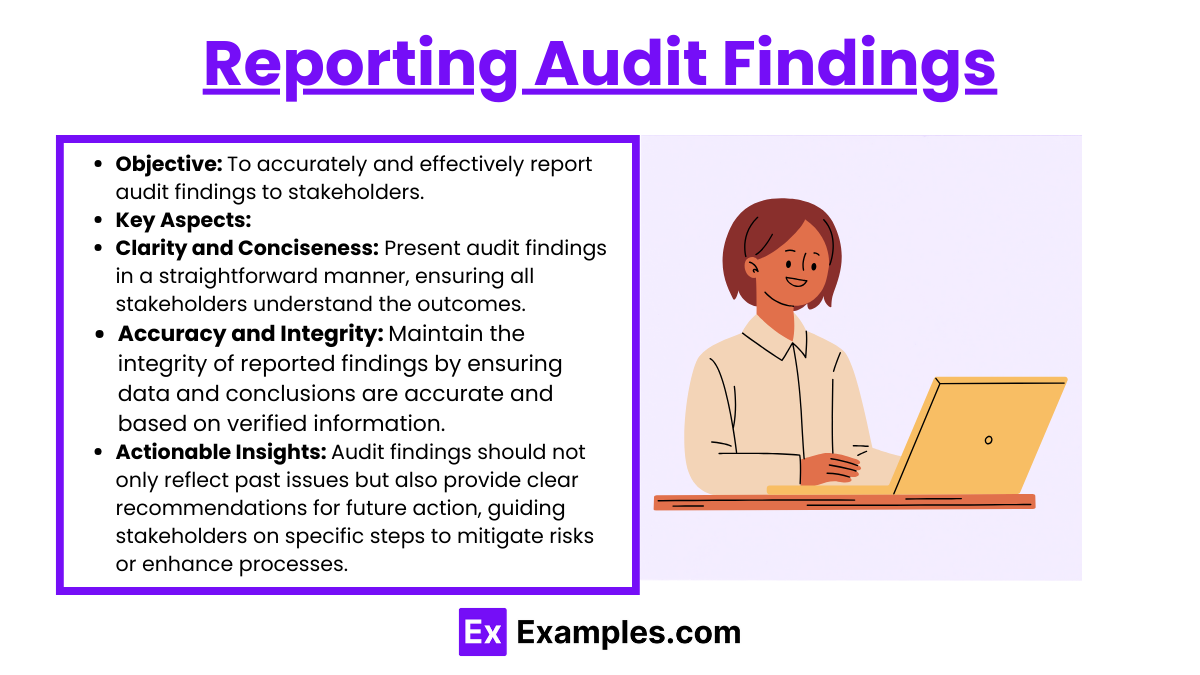
- Objective: To accurately and effectively report audit findings to stakeholders.
- Key Aspects:
- Clarity and Conciseness: Present audit findings in a straightforward manner, ensuring all stakeholders understand the outcomes.
- Accuracy and Integrity: Maintain the integrity of reported findings by ensuring data and conclusions are accurate and based on verified information.
- Actionable Insights: Audit findings should not only reflect past issues but also provide clear recommendations for future action, guiding stakeholders on specific steps to mitigate risks or enhance processes.
2. Effective Communication with Stakeholders
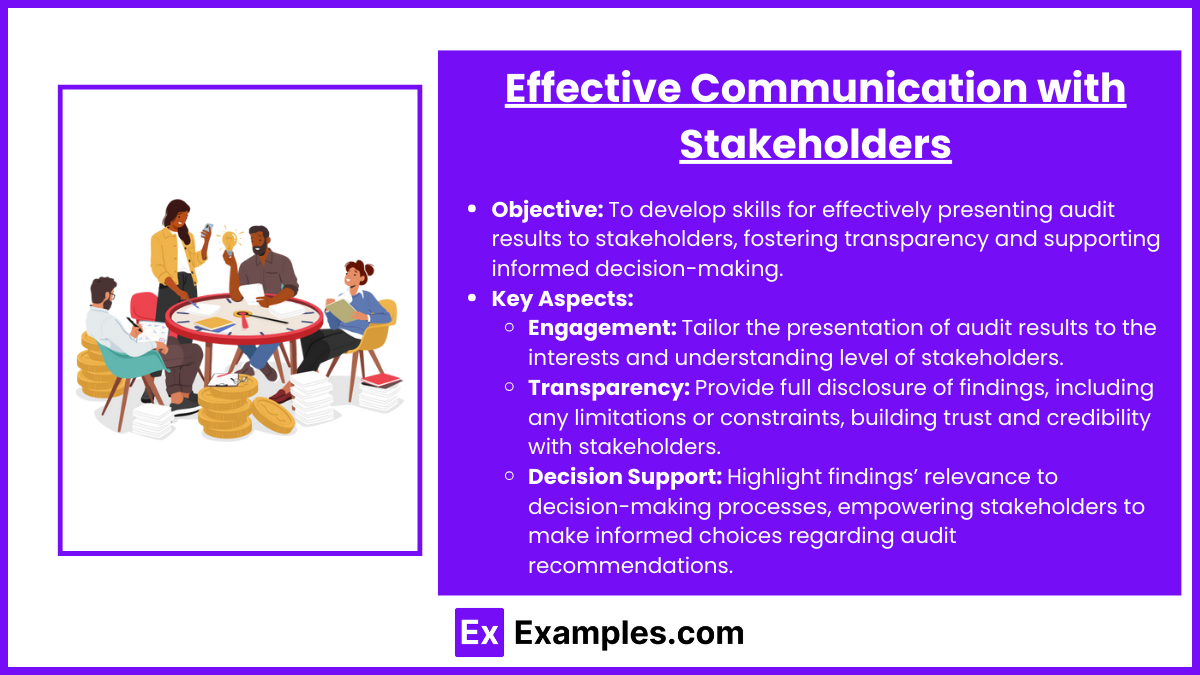
- Objective: To develop skills for effectively presenting audit results to stakeholders, fostering transparency and supporting informed decision-making.
- Key Aspects:
- Engagement: Tailor the presentation of audit results to the interests and understanding level of stakeholders.
- Transparency: Provide full disclosure of findings, including any limitations or constraints, building trust and credibility with stakeholders.
- Decision Support: Highlight findings’ relevance to decision-making processes, empowering stakeholders to make informed choices regarding audit recommendations.
3. Adherence to Reporting Standards
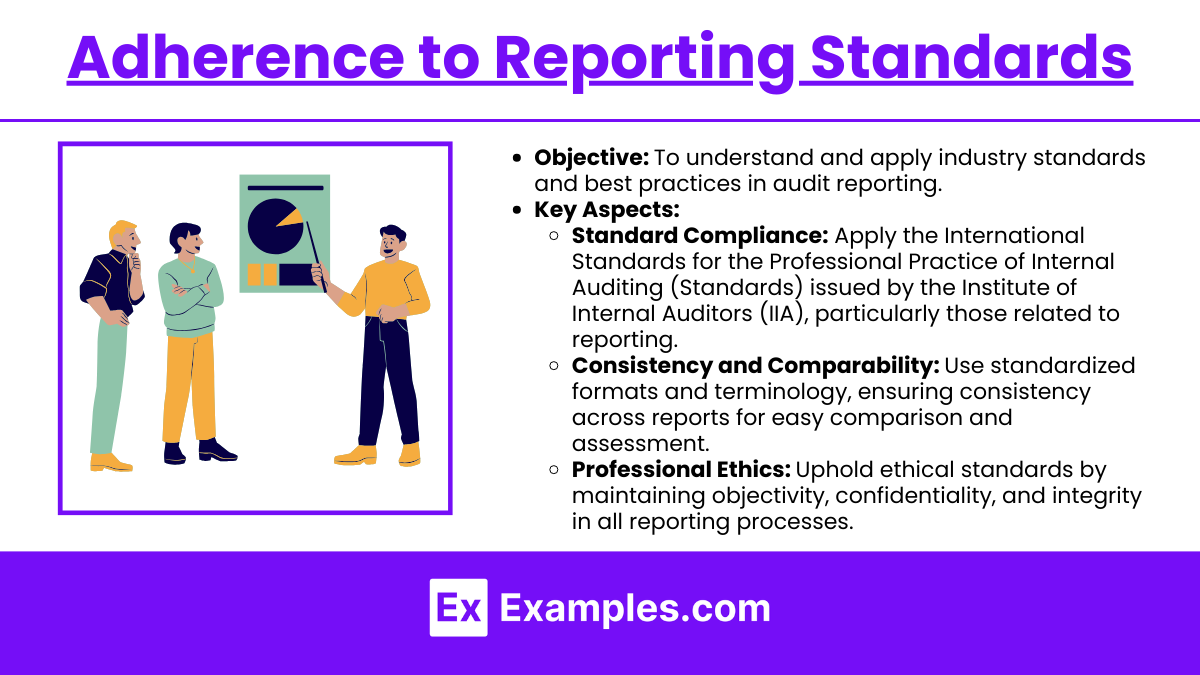
- Objective: To understand and apply industry standards and best practices in audit reporting.
- Key Aspects:
- Standard Compliance: Apply the International Standards for the Professional Practice of Internal Auditing (Standards) issued by the Institute of Internal Auditors (IIA), particularly those related to reporting.
- Consistency and Comparability: Use standardized formats and terminology, ensuring consistency across reports for easy comparison and assessment.
- Professional Ethics: Uphold ethical standards by maintaining objectivity, confidentiality, and integrity in all reporting processes.
4. Alignment with Organizational Goals
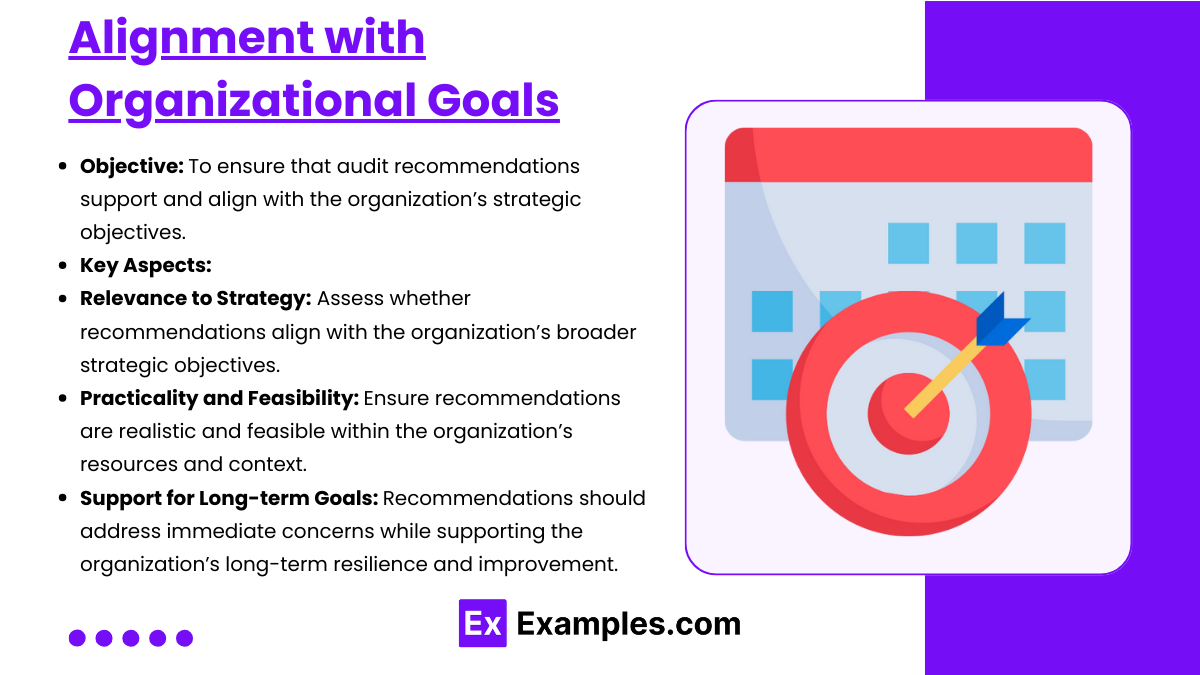
- Objective: To ensure that audit recommendations support and align with the organization’s strategic objectives.
- Key Aspects:
- Relevance to Strategy: Assess whether recommendations align with the organization’s broader strategic objectives.
- Practicality and Feasibility: Ensure recommendations are realistic and feasible within the organization’s resources and context.
- Support for Long-term Goals: Recommendations should address immediate concerns while supporting the organization’s long-term resilience and improvement.
Key Areas of Focus for Communicating Engagement Results
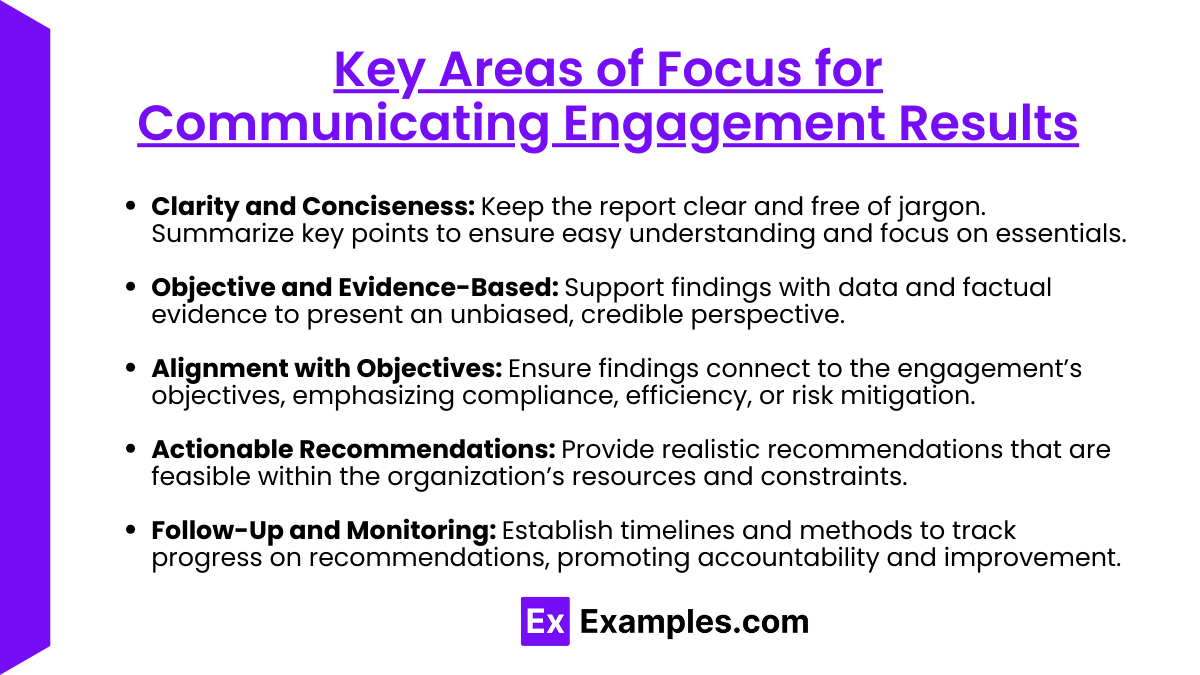
Here are some key areas of focus for effectively communicating engagement results in an audit or internal review process:
1. Clarity and Conciseness
- Ensure that the report is straightforward, avoiding unnecessary jargon. Summarize findings in clear terms that the audience can easily understand. Highlight the most critical points to avoid overwhelming readers with details.
2. Objective and Evidence-Based Reporting
- Use data and factual evidence to back up findings. Each observation should be supported by sufficient documentation, ensuring that the report reflects an unbiased perspective. This builds credibility and facilitates actionable insights.
3. Alignment with Objectives and Scope
- Tailor the results to match the original objectives and scope of the engagement. Reinforce how findings relate to the engagement goals, focusing on areas of compliance, efficiency, or risk mitigation as outlined in the initial engagement plan.
4. Actionable Recommendations
- Offer specific, realistic recommendations to address identified issues. Recommendations should be practical, taking into account the organization’s resources and constraints, and should guide the organization on how to implement improvements effectively.
5. Follow-Up and Monitoring Mechanisms
- Outline a clear process for follow-up on recommendations. This may include establishing timelines for improvements and setting up methods for tracking progress, helping to ensure accountability and continuous improvement.
6. Timeliness
- Share engagement results promptly to enable the organization to take action on findings in a timely manner. Delays in reporting may diminish the relevance and impact of the results.
7. Audience-Specific Customization
- Customize the communication to suit different stakeholders. For example, executives may require a high-level summary, while operational managers may benefit from more detailed insights and guidance for practical implementation.
8. Visual Aids for Enhanced Understanding
- Use charts, graphs, and other visual elements to present data effectively. Visuals can clarify complex information and enhance the engagement of the audience, making it easier for them to grasp key points quickly.
Examples
Example 1. Tracking Key Performance Indicators (KPIs) in Project Audits
Communicating engagement results and monitoring progress in project audits involves setting clear KPIs from the outset. For instance, an auditor working on a project might regularly report on completion percentages, budget usage, and time milestones to stakeholders. These updates ensure that project managers and decision-makers have a clear view of where the project stands, how well it aligns with expected outcomes, and if any adjustments are needed. Tracking KPIs allows for transparent communication, which is essential to foster trust and collaborative problem-solving when challenges arise.
Example 2. Financial Reporting in Internal Audit Reviews
In an internal audit review, communicating the results effectively includes presenting financial findings in a manner that highlights both strengths and areas for improvement. For example, an internal auditor might create a quarterly report on expense management practices across departments, emphasizing compliance with organizational policies. This report, communicated to upper management, enables ongoing monitoring of financial practices and provides a basis for adjusting future spending strategies to improve resource allocation and operational efficiency.
Example 3. Compliance Monitoring in Risk Assessment
During risk assessments, particularly in heavily regulated industries, auditors often monitor and communicate compliance statuses to relevant stakeholders. For example, in a healthcare organization, auditors might assess adherence to patient data privacy standards. By providing regular updates on compliance levels and identifying any areas of non-compliance, the auditor ensures that management is fully aware of risks, facilitating proactive remediation steps. Consistent communication and progress monitoring in this context protect the organization from potential regulatory penalties.
Example 4. Process Improvement in Operational Audits
Communicating engagement results in operational audits often includes tracking the progress of implemented process improvements. An operational audit might identify bottlenecks in the supply chain and suggest improvements to reduce delivery times. Regular follow-up reports on these improvements keep management informed of progress, helping assess whether the changes are positively impacting operational efficiency. Continuous monitoring and communication of these outcomes reinforce accountability, which is critical to ensuring sustained improvements.
Example 5. Employee Training Evaluation in Compliance Audits
Effective communication and progress monitoring are essential in tracking compliance training among employees. For instance, an auditor may track and report on the completion rates of required training modules, flagging areas where employees need additional support or refresher training. By communicating these results to HR and compliance officers, the organization can address gaps promptly, ensuring that staff is fully prepared to adhere to regulatory standards and mitigate risk. This ongoing communication ensures that training programs meet their intended objectives, contributing to a compliant and informed workforce.
Practice Questions
Question 1
Which of the following is the primary purpose of communicating engagement results?
A) To provide actionable insights for improving operations
B) To document the entire engagement process
C) To ensure compliance with regulatory requirements
D) To summarize the auditor’s activities and findings for internal records
Answer: A) To provide actionable insights for improving operations
Explanation:
The primary goal of communicating engagement results is to provide stakeholders with insights and recommendations that can help improve processes, reduce risks, and enhance the efficiency of operations. While documenting the process and ensuring compliance are important, the core purpose is to give valuable information that management can use to make informed decisions.
Question 2
Which element should be included in the engagement report to effectively communicate audit findings?
A) Only a summary of major issues discovered
B) Detailed descriptions of corrective actions implemented by management
C) Clear, concise findings with recommendations for improvement
D) Only compliance-related issues
Answer: C) Clear, concise findings with recommendations for improvement
Explanation:
An effective engagement report should communicate findings in a manner that is clear, concise, and focused on recommendations for improvement. This helps stakeholders understand the issues and provides them with actionable steps to address those issues. Including too much detail about corrective actions or focusing solely on compliance would make the report less impactful and could detract from its purpose of providing improvement-focused insights.
Question 3
Monitoring progress after communicating engagement results is essential because:
A) It ensures that all engagement recommendations are strictly followed
B) It confirms that management has implemented agreed-upon corrective actions
C) It allows the auditor to close the engagement formally
D) It provides an opportunity for auditors to conduct a follow-up audit immediately
Answer: B) It confirms that management has implemented agreed-upon corrective actions
Explanation:
Monitoring progress is a follow-up activity to ensure that management has effectively implemented the recommended actions. This process allows internal auditors to verify that management’s corrective actions have addressed the findings. It also demonstrates accountability and encourages continuous improvement. Simply conducting a follow-up audit immediately or closing the engagement isn’t the purpose; it’s about confirming management’s adherence to recommendations for ongoing effectiveness.

